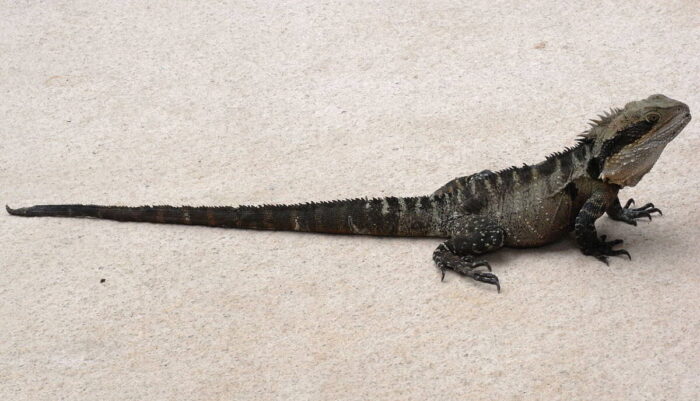Table of Contents
Water dragons are fascinating reptiles that are sometimes kept as pets. However, they do have very specific needs, so it is important to know what you are getting and what is required of you before you decide on this type of pet. They can live for around ten to fifteen years but require specific temperatures in order to thrive. You will also need to provide both a basking area and a place for the water dragon to swim about in. Sounds straightforward so far, right?
Well, what you might not realize is that the water dragon’s water will need to be changed every day as the creature will poop in the water. This will obviously then become contaminated. If you leave the water too long in this condition, an excess of bacteria could thrive which could end up being harmful to the dragon. If you are still keen on keeping one of these beautiful reptiles, read on to learn a bit more about looking after them.
What Do Water Dragons Look Like?
Water dragons, or specifically Asian water dragons , are often referred to as green water dragons because of their coloring. Adults typically range from a dark to light green in color, with a lower body that is a light yellow or white. They also have vertical stripes down the side of their body, which tend to be pale or mint green in color (they can sometimes be turquoise or aqua). Water dragons sometimes have colorful throats, which can range from pale yellow to peach, orange, pink, and even purple.
, are often referred to as green water dragons because of their coloring. Adults typically range from a dark to light green in color, with a lower body that is a light yellow or white. They also have vertical stripes down the side of their body, which tend to be pale or mint green in color (they can sometimes be turquoise or aqua). Water dragons sometimes have colorful throats, which can range from pale yellow to peach, orange, pink, and even purple.
As juveniles however, water dragons are not as colorful as their adult counterparts. Juveniles are typically of a more brown color with a pale green or whiteish lower abdomen. Their vertical stripes tend to be white or beige. As they grow and start shedding their skin, they will start to change their color to become the more recognizable green of an adult.
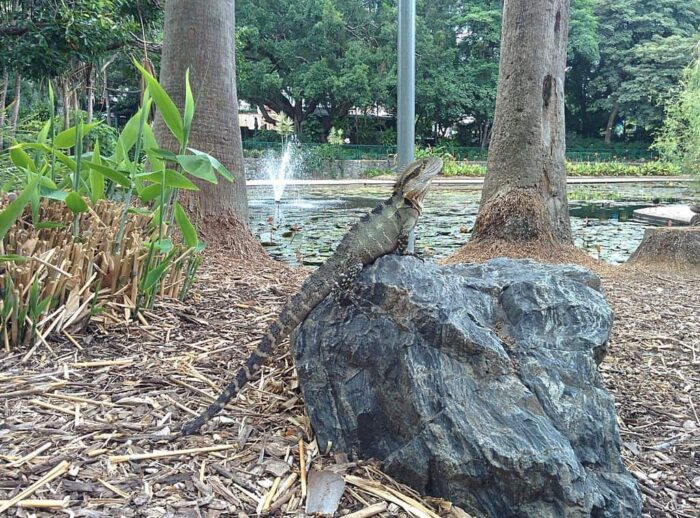
Basking Australian Water Dragon (Intellagama lesueurii) 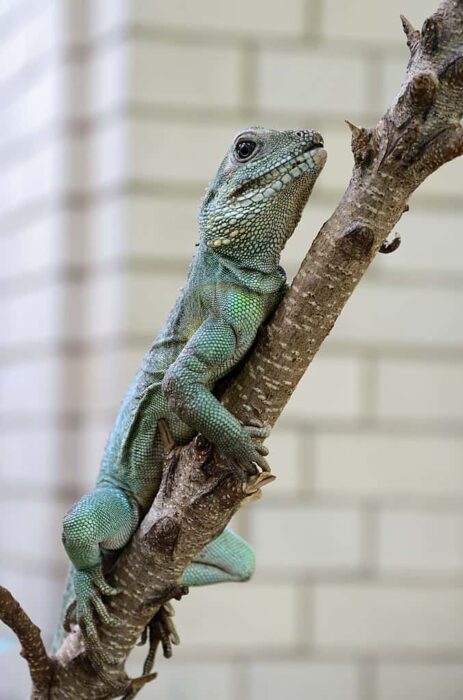
Chinese Water Dragon (Physignathus cocincinus) 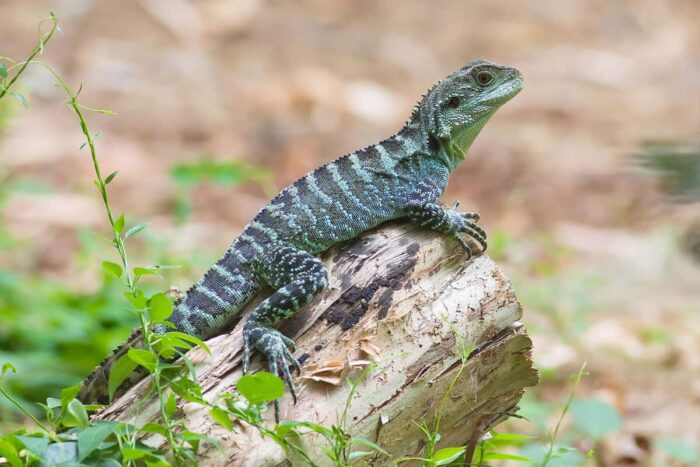
Gippsland Water Dragon (Physignathus lesueurii howittii)
Why is My Water Dragon Turning Brown?
Water dragons are capable of changing color from their natural green to a brown color; this is done for a number of reasons. The first of these is age. As mentioned above, juveniles tend to be a brown color, staying this way for the first year or so (so a water dragon under the age of one is almost always brown in color). Nevertheless, if the water dragon is older than this and has changed from green to brown, you might be wondering why this has occurred.
Well, a water dragon that has turned a brown color may be feeling stressed. This can often result from a change in environment. For example, if you have recently obtained the animal and placed it in a new cage/enclosure. It will take the dragon a bit of time to get used to its new surroundings. The best thing to do in this situation is to leave it to adjust while offering food every two to three days. Do not be surprised if it becomes a bit picky with its food during this time too. You should though notice a difference after a week or two.
If your water dragon is not new and has suddenly changed to a brown color, it could be that the temperature of the enclosure is not optimal. Daytime temperatures should be between 80F and 86F while nighttime temperatures should drop to between 70F and 77F. You will also need a basking area with a higher temperature of around 95F (but no higher than this). Water dragons require a full light spectrum with twelve hours of daylight and twelve hours of night. If the temperature becomes too cold in the tank, it can result in the reptile getting stressed and changing to a brown color.
A change in color can also signify an illness. If the water dragon has developed brown patches on its skin, this could be an indication of a bacterial or fungal infection. If you notice this, call your vet to have the creature checked out. It might be necessary to apply an anti-fungal cream to the area.
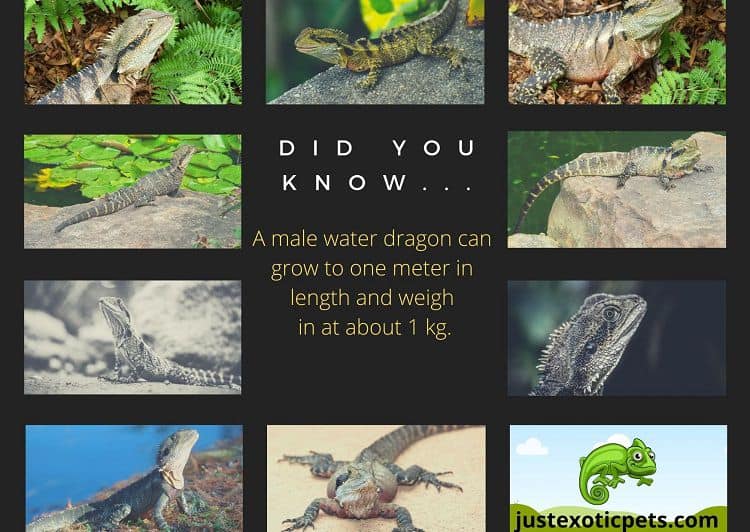
Why is My Water Dragon Black?
As you have probably by now gathered from the rest of this article, darkness of color in a water dragon is usually a sign of stress or illness. If you have changed anything in the water dragon’s tank, it could be causing stress. Even adding new items to the tank can cause the water dragon to become upset or stressed out.
If it continues to stay a dark/black color, it would be best to seek advice from an experienced tropical vet who will be able to check your pet over to ensure there is no underlying illness.
Conclusion
Water dragons make for wonderful pets and can bring great joy to those who care for them. However, knowing as much as you can about these amazing creatures before getting one will help you to provide the best care possible. Armed with as much knowledge as possible about their needs and behaviors will ensure the dragon thrives for many years.
Photo Credits:
- Featured Image (Eastern Water Dragon): Quartl
 – This file is licensed under the Creative Commons
– This file is licensed under the Creative Commons Attribution-Share Alike 3.0 Unported
Attribution-Share Alike 3.0 Unported license.
license. - Gippsland Water Dragon: JJ Harrison
 (https://www.jjharrison.com.au/
(https://www.jjharrison.com.au/ ) – This file is licensed under the Creative Commons
) – This file is licensed under the Creative Commons Attribution-Share Alike 3.0 Unported
Attribution-Share Alike 3.0 Unported license.
license. - Chinese Water Dragon: Alvesgaspar
 – This file is licensed under the Creative Commons
– This file is licensed under the Creative Commons Attribution-Share Alike 4.0 International
Attribution-Share Alike 4.0 International license.
license. - Basking Australian Water Dragon: MusikAnimal
 – This file is licensed under the Creative Commons
– This file is licensed under the Creative Commons Attribu
Attribu tion-Share Alike 4.0 International license.
tion-Share Alike 4.0 International license.

